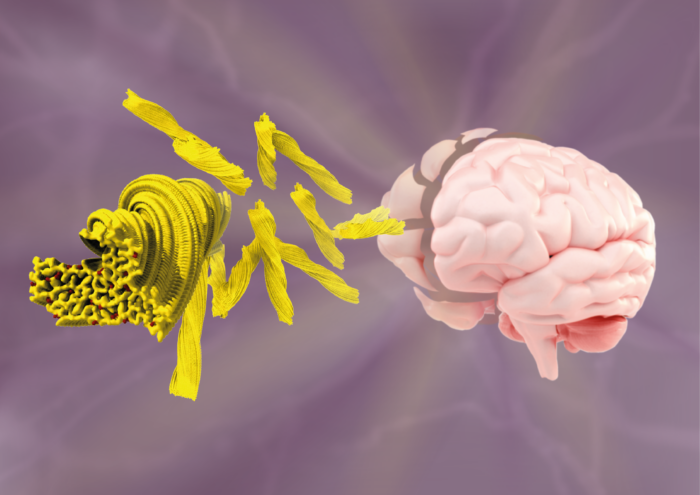It was widely assumed that pathological amyloid filaments in certain cases of frontotemporal lobar degeneration are formed by the protein FUS, but cryo-EM has unexpectedly revealed that they are instead formed by the protein TAF15.

Neurodegenerative disorders are characterised by the formation of amyloid filament inclusions of specific proteins in the brain. For most of these disorders, the filament-forming proteins have been identified and represent the prime targets for the effective diagnosis and treatment of the diseases that they associate with.
The neurodegenerative disorder frontotemporal lobar degeneration (FTLD) causes frontotemporal dementia, the most common form of dementia after Alzheimer’s disease. Yet, in approximately 10% of cases of FTLD, the filament forming protein was unknown. The filaments were widely assumed to be formed by the protein FUS, due to the presence of this protein in the brain inclusions and genetic evidence for its role in rare cases of another neurodegenerative disorder, amyotrophic lateral sclerosis.
To investigate this mystery, Benjamin Ryskeldi-Falcon’s group in the LMB’s Neurobiology Division isolated amyloid filaments from multiple brain regions of four individuals with this type of FTLD. Donated brain samples were identified by Tammaryn Lashley at the University College London Queen Square Institute of Neurology and Bernardino Ghetti at the Indiana University School of Medicine, whose groups carried out neuropathological examinations.
Using electron cryo-microscopy, lead author Stephan Tetter, a postdoc in Benjamin’s group, found that a single, identical amyloid filament structure was shared among all individuals. The high-resolution of the structures enabled direct sequencing of the filament-forming protein. To the researchers’ surprise, it was not FUS that formed the filaments, but another member of the same protein family, TAF15.
This work uncovers the molecular pathology of this type of FTLD. It represents a rare finding of a new member of the small group of proteins known to form neurodegenerative disease-associated amyloid filaments, alongside proteins such as amyloid-b, tau, TDP-43 and a-synuclein. The study establishes TAF15 as a target for the diagnosis and treatment of neurodegenerative disease.
This work was funded by UKRI MRC, Alzheimer’s Research UK, US National Institutes of Health, the Alzheimer’s Society, the Association for Frontotemporal Degeneration, the Swiss National Science Foundation, and the Leverhulme Trust.
Further references
TAF15 amyloid filaments in frontotemporal lobar degeneration. Tetter, S., Arseni, D., Murzin, AG., Buhidma, Y., Peak-Chew, SY., Garringer, HJ., Newell, KL., Vidal, R., Apostolova, L.G., Lashley, T., Ghetti, B., Ryskeldi-Falcon, B. Nature
Benjamin’s group page
Bernardino Ghetti, Indiana University School of Medicine, USA
Tammaryn Lashley, University College London Queen Square Institute of Neurology
Previous Insight on Research articles
Structural breakthrough in study of aggregated TDP-43 protein in brains of ALS and FTD sufferers
TDP-43 forms amyloid filaments with distinct folds in different neurodegenerative conditions